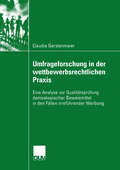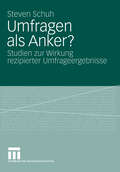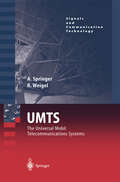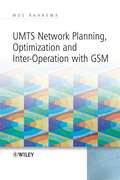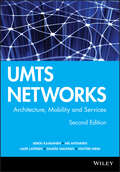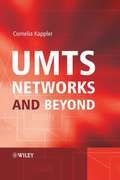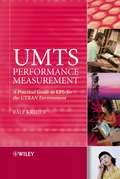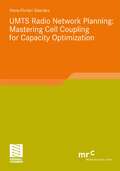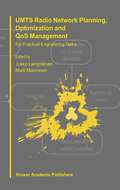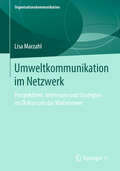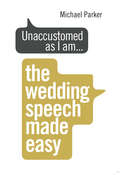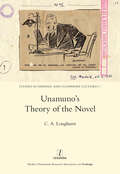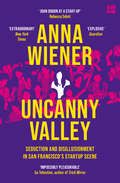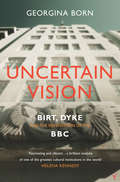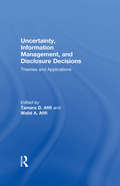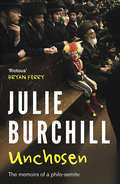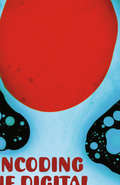- Table View
- List View
Umfrageforschung in der wettbewerbsrechtlichen Praxis: Eine Analyse zur Qualitätsprüfung demoskopischer Beweismittel in den Fällen irreführender Werbung (Sozialwissenschaft)
by Claudia GerstenmaierWerbung ist ein essentielles Mittel im Wettbewerb. Doch kann der Werbetreibende nach dem Gesetz gegen den unlauteren Wettbewerb (UWG) zur Unterlassung irreführender Angaben verpflichtet werden. Bei einem Rechtsstreit erlangen demoskopischer Gutachten über das Verständnis von Werbeaussagen prozessentscheidende Bedeutung. Dieses Buch stellt erstmals Prüfkriterien für die Beurteilung der Objektivität und Neutralität demoskopischer Gutachtens in der wettbewerbsrechtlichen Praxis auf.
Umfragen als Anker?: Studien zur Wirkung rezipierter Umfrageergebnisse
by Steven SchuhMit Prognosen ist das so eine Sache. Als Doktorand gelangt man zu dieser Einsicht spätestens, wenn der erste anvisierte Abgabetermin für die selbstverständlich noch unvollendete Dissertation verstrichen ist und die eigentlich gut gemeinten Nachf- gen von Freunden und Bekannten diese Fehleinschätzung schmerzvoll spürbar machen. Erst viel später wagt man sich zu fragen, ob es vielleicht nur die letztlich allzu optimistische Prognose gewesen sein könnte, die den Glauben an einen erfo- reichen Abschluss lange Zeit getragen hat und ob es ohne sie vielleicht nie zu d- sem Vorwort gekommen wäre? Über die Fähigkeit von Prognosen, Ergebnisse in ihre Richtung zu beeinfl- sen, lässt sich jedenfalls trefflich spekulieren. Das vorliegende Werk zur Wirkung veröffentlichter Umfrageergebnisse kann dies nicht nur theoretisch dokumentieren, es lädt mit seinen empirischen Einsichten auch dazu ein. Zugleich macht diese Arbeit deutlich, dass wohl kein Politiker ausschließlich dank positiver Prognosen Wahlen gewinnen und keine Dissertation nur wegen ihnen Vollendung finden dü- te. Erfolg hat immer viele Väter. Deshalb möchte ich mich bei all den Menschen bedanken, ohne die es nicht möglich gewesen wäre, meine Dissertation im März 2008 dem Fachbereich 02 – Sozialwissenschaften, Medien und Sport der Johannes Gutenberg-Universität Mainz vorzulegen und meine Promotion abzuschließen. Mein erster Dank geht an Professor Dr. Christina Holtz-Bacha, die mich nach Abschluss meines Studiums ermuntert hat zu promovieren und mir jederzeit mit gutem Rat zur Seite stand. Bedanken möchte ich mich auch bei Professor Dr. Axel Mattenklott für sein Engagement als Zweitgutachter.
Umhegt oder abhängig?: Der Mensch in einer digitalen Umgebung
by Jörg Eberspächer Wolf Von RedenDigitalisierung und Miniaturisierung von informations- und kommunikationstechnischen Funktionselementen schreiten rasch voran. Die allgegenwärtige digitale Assistenz für den Menschen beginnt Realität zu werden. Das Tempo der technischen Entwicklung und die Erprobung neuer unterstützender Dienste macht eine Auseinandersetzung mit der Frage erforderlich, wie dieser Fortschritt in nachhaltiger Weise zum Nutzen des Menschen gestaltet werden kann und welche Besonderheiten auf dem Weg dorthin zu beachten sind. Der MÜNCHNER KREIS hat mit hochrangigen Fachleuten aus Wissenschaft und Industrie aktuelle Erkenntnisse und Perspektiven diskutiert. Die hinter den Schlagworten ambient intelligence, ubiquitous computing oder pervasive computing stehenden Zukunftsszenarien wurden fundiert eingeschätzt und gestaltet. Das vorliegende Buch enthält die Ergebnisse.
UMTS: The Physical Layer of the Universal Mobile Telecommunications System (Signals and Communication Technology)
by Andreas Springer Robert WeigelWritten with the expert in mind the book describes the physical layer of UMTS (Universal Mobile Telecommunication System). In a clear fashion it compiles the main technical features of the physical layer standard together with a description of the basic digital communications and spread spectrum technology. In addition the test cases specified in the standard are described together with their implications on any practical front-end design. The reader will benefit from the standard description which frees him from studying lots of standardization documents. Additional explanations of the standard and especially the test cases will help to better understand the effects on any front-end system design. Many references are provided for readers interested in in-depth treatments of certain topics.
UMTS Network Planning, Optimization, and Inter-Operation with GSM (Wiley - IEEE)
by Moe RahnemaUMTS Network Planning, Optimization, and Inter-Operation with GSM is an accessible, one-stop reference to help engineers effectively reduce the time and costs involved in UMTS deployment and optimization. Rahnema includes detailed coverage from both a theoretical and practical perspective on the planning and optimization aspects of UMTS, and a number of other new techniques to help operators get the most out of their networks. Provides an end-to-end perspective, from network design to optimization Incorporates the hands-on experiences of numerous researchers Single authorship allows for strong coherency and accessibility Details the complete iteration cycle of radio link budgeting for coverage planning and dimensioning Rahnema demonstrates detailed formulation of radio capacity and coverage in UMTS, and discusses the tradeoffs involved. He presents complete link budgeting and iterative simulations for capacity and coverage planning, along with practical guidelines. UMTS Network Planning contains seventeen cohesive and well-organized chapters which cover numerous topics, including: Radio channel structures, radio channel models, parameters, model tuning Techniques for capacity and coverage enhancements Complete treatment of power control, handoffs and radio resource practical management processes and parameters Detailed coverage of TCP protocol enhancement for operation over wireless links, particularly UMTS Application of GSM measurements to plan and re-engineer for UMTS radio sites Guidelines for site co-location with GSM, the QOS classes, parameters and inter-workings in UMTS AMR voice codecs and tradeoffs, core and access network design, architectural evolution, and protocols Comprehensive discussion and presentation of practical techniques for radio performance analysis, trending, and troubleshooting Perfect for professionals in the field and researchers specializing in network enhancement. Engineers working on other air interfaces and next generation technologies will find many of the techniques introduced helpful in designing and deploying future wireless networks as well. Students and professionals new to the wireless field will also find this book to be a good foundation in network planning, performance analysis, and optimization.
UMTS Networks: Architecture, Mobility and Services
by Heikki Kaaranen Ari Ahtiainen Lauri Laitinen Siamäk Naghian Valtteri NiemiBuilding on the success of the first edition, UMTS Networks second edition allows readers to continue their journey through UMTS up to the latest 3GPP standardization phase, Release 5. Containing revised, updated and brand new material, it provides a comprehensive view on the UMTS network architecture and its latest developments. Accompanied by numerous illustrations, the practical approach of the book benefits from the authors’ pioneering research and training in this field. Provides a broad yet detailed overview of the latest worldwide developments in UMTS technology. Includes brand new sections on the IP Multimedia Subsystem and High Speed Downlink Packet Access according to 3GPP Release 5 specifications. Contains heavily revised sections on the evolution from GSM to UMTS Multi-access, the UMTS Radio Access Network, the UMTS Core Network and services. Includes updated versions on services in the UMTS environment, security in the UMTS environment and UMTS protocols. Illustrates all points with cutting-edge practical examples gleaned from the authors’ research and training at the forefront of UMTS. The illustrative, hands-on approach will appeal to operators, equipment vendors, systems designers, developers and marketing professionals who require comprehensive, practical information on the latest developments in UMTS. This second edition will also benefit students and researchers in the field of mobile networking.
UMTS Networks and Beyond
by Cornelia KapplerAn all-encompassing coverage on UMTS Networks including an in-depth discussion of current work on UMTS evolution and 4G . UMTS Networks and Beyond offers a comprehensive introduction to the networking aspects of UMTS and the networks coming after UMTS. The book is unique in that it systematically compares how a particular problem, e.g. obtaining connectivity, is solved in UMTS and how the same problem is solved in a Computer Network such as the Internet. It also highlights why the respective solutions are so different. The first part of the book provides a detailed technical discussion of UMTS, including original vision, architecture, protocol stacks and overall functionality. It places UMTS in the context of its evolution of from GSM and its convergence with Computer Networks. The second part of the book discusses today’s vision of 4G, and introduces upcoming networking technologies. Emphasis is on LTE / SAE as successor of UMTS; UMB, WiMAX and NGN are also discussed. The book gives an overview of what these technologies are likely to offer, of their architectures, protocols and functionality. It also discusses their differences and similarities, and whether they will qualify as 4G. Key Features: Provides readers, particularly those with a background in IP-based networks, with a technical understanding of what UMTS does, how it works and how it is likely to evolve Explains the differences in design between UMTS Networks and Computer Networks and discusses how these design divergences can be reconciled in the future Shows how economic considerations shape the design of UMTS Motivates why particular design choices are made in UMTS Gives an in-depth introduction to LTE / SAE Provides a detailed picture of the state of the art in 4G Illustrates the theory with numerous tables and figures This comprehensive textbook is essential reading for advanced students and lecturers in communications systems and networking. It is also of interest to engineers and researchers in the field of UMTS and communications systems.
UMTS: Origins, Architecture and the Standard (Computer Communications and Networks)
by Pierre LescuyerTranslated from the second edition of a successful French publication, this book has been thoroughly updated to include full coverage of the new UMTS standard. It looks at the topic from a system's point of view and covers both the architecture and the techniques employed in the UMTS network. The introductory chapters cover the origins of UMTS and its relation to the other third generation technologies. The later chapters are more technical and describe different aspects such as the architecture, the structure of the radio interface, the protocols used and the importance of the GSM inheritance.
UMTS Performance Measurement: A Practical Guide to KPIs for the UTRAN Environment
by Ralf KreherUMTS Performance Measurement is a practical guide that explains how to identify and measure the main problems seen in today's UMTS live networks and will make performance measurement results gathered in the UTRAN environment understandable for the reader. It provides a fundamental background for daily work in the field or lab, covering a wide range of performance measurements that help to troubleshoot and optimize the UTRAN environment. The content goes far beyond what has been defined by international standard bodies like 3GPP and closes the gap between international standards and definitions of network equipment manufacturers (NEM) and network operators. The emphasis is on definition of Key Performance Indicators (KPIs) and measurements that are not described in 3GPP standard documents, such as throughput measurements and the success/failure analysis of all possible handover types. Includes clear coverage of the fundamentals of performance measurement software architecture and ways to collect and present statistical data Contains numerous call flow diagrams, conversion tables, protocol message examples and sample measurement results that can be used as reference for daily work in the field or lab Explains measurement limitations and how tolerances provide valuable information for validation and evaluation of measurement results Provides an overview of how performance measurement software works as well as information on how data streams are captured and analyzed, and how analysis results are aggregated and presented in graphic user interfaces and reports Providing a gateway into the world of UMTS-specific measurement scenarios and a general overview of what can be defined and measured at an in-depth technical level, this book will appeal to those involved in network operation, planning, configuration and deployment, as well as consulting and training companies, students, technical journalists and measurement equipment manufacturers.
UMTS Radio Network Planning: Mastering Cell Coupling for Capacity Optimization (Advanced Studies Mobile Research Center Bremen)
by Hans-Florian GeerdesThe author establishes a concise system model for UMTS radio networks, which describes interference coupling and its impact on the network. This model is the basis for efficient radio network performance analysis as well as new optimization methods for automatic planning.
UMTS Radio Network Planning, Optimization and QOS Management: For Practical Engineering Tasks
by Jukka Lempiäinen Matti ManninenIn cellular networks, a new generation of CDMA or WCDMA-based networks will start operations in most countries in the near future. The standardized WCDMA technology generates new challenges in radio network planning, optimization and QoS management because of the dynamic nature of its radio interface and various new services and different network operating modes. Moreover, new and modified radio planning phases as well as new field measurements and emphasized QoS management are needed when UMTS networks are designed and optimized. Hence, a practical UMTS planning process must be defined in detail, from dimensioning to optimization tasks. This book follows the UMTS planning process. It is organized in three parts: Part I - UMTS configuration planning; Part II - UMTS topology planning; and Part III - UMTS network functionality. The first chapter in Part I introduces the UMTS and UTRAN systems and radio network planning strategy, and defines a planning process for UMTS. In Chapter 2, the UMTS planning process is covered, and a detailed description of the UMTS power budget is given, with planning threshold examples provided.
UMTS Security
by Valtteri Niemi Kaisa NybergCan you afford not to read this book?........ The Universal Mobile Telecommunication System (UMTS) offers a consistent set of services to mobile computer and phone users and numerous different radio access technologies will co-exist within the UMTS system's core network - security is, therefore, of the utmost importance. UMTS Security focuses on the standardized security features of UMTS and brings together material previously only available in specifications, design documents and presentations in one concise form. In addition, this unique volume also covers non-standard implementation specific features that allow differentiation between operators and manufacturers. * Describes the security solutions specified for UMTS * Provides a comprehensive presentation of the UMTS security specifications and explains the role of the security functionality in the UMTS system * Presents the UMTS security system in its totality from the theoretical background through to the design process * Discusses the new security features included in Release 4 and 5 By providing a unified treatment of the security services provided by the UMTS system, this volume will provide invaluable information and have instant appeal to planners, constructers and implementers of UMTS networks, and developers and analysts of application oriented security services that make use of UMTS communication networks. It will also be of considerable interest to postgraduates and researchers of modern communication security technology.
Umweltkommunikation im Netzwerk: Perspektiven, Interessen und Strategien im Diskurs um das Wattenmeer (Organisationskommunikation)
by Lisa MarzahlLisa Marzahl widmet sich der Frage, wie Organisationen aus Politik, Wirtschaft und Zivilgesellschaft Umweltdiskurse beeinflussen, indem sie ihre Perspektiven, Interessen und Ziele miteinander ausspielen. In einer Fallstudie zum schleswig-holsteinischen Wattenmeer-Nationalpark zeichnet sie die Netzwerkarbeit und das Ausgleichen von Interessen zwischen Organisationen in diesem speziellen Umweltdiskurs nach und leitet daraus verschiedene Verhältnisse und Beziehungsarten sowie entscheidende Bausteine der Netzwerksteuerung ab, die für eine Zusammenarbeit von politischen Organisationen, Unternehmen sowie Umwelt- und Naturschutzverbänden im Umweltbereich entscheidend sind.
Unaccustomed as I am...: The Wedding Speech Made Easy
by Michael ParkerAll wedding types will be catered for: big, small, religious, second marriage, atheist, straight, same-sex, church, field... All speakers will be addressed: bride, groom, father, mother, best woman and literally everyone in between... All eventualities will be planned for: mic failures, drunk guests, missing brides, smashed glasses, weeping FOBs, forgotten words... All of which will be delightfully and wittily illustrated, with a mix of little-known wedding facts and a whole host of inspirational (or not) quotations.
Unamuno's Theory of the Novel
by C.A. LonghurstMiguel de Unamuno (1864-1936) is widely regarded as Spain's greatest and most controversial writer of the first half of the twentieth century. Professor of Greek, and later Rector, at the University of Salamanca, and a figure with a noted public profile in his day, he wrote a large number of philosophical, political and philological essays, as well as poems, plays and short stories, but it is his highly idiosyncratic novels, for which he coined the word nivola, that have attracted the greatest critical attention. Niebla (Mist, 1914) has become one of the most studied works of Spanish literature, such is the enduring fascination which it has provoked. In this study, C. A. Longhurst, a distinguished Unamuno scholar, sets out to show that behind Unamuno's fictional experiments there lies a coherent and quasi-philosophical concept of the novelesque genre and indeed of writing itself. Ideas about freedom, identity, finality, mutuality and community are closely intertwined with ideas on writing and reading and give rise to a new and highly personal way of conceiving fiction.
Unamuno's Theory of the Novel
by C.A. LonghurstMiguel de Unamuno (1864-1936) is widely regarded as Spain's greatest and most controversial writer of the first half of the twentieth century. Professor of Greek, and later Rector, at the University of Salamanca, and a figure with a noted public profile in his day, he wrote a large number of philosophical, political and philological essays, as well as poems, plays and short stories, but it is his highly idiosyncratic novels, for which he coined the word nivola, that have attracted the greatest critical attention. Niebla (Mist, 1914) has become one of the most studied works of Spanish literature, such is the enduring fascination which it has provoked. In this study, C. A. Longhurst, a distinguished Unamuno scholar, sets out to show that behind Unamuno's fictional experiments there lies a coherent and quasi-philosophical concept of the novelesque genre and indeed of writing itself. Ideas about freedom, identity, finality, mutuality and community are closely intertwined with ideas on writing and reading and give rise to a new and highly personal way of conceiving fiction.
Uncanny Valley: A Memoir
by Anna Wiener‘Joan Didion at a startup’ Rebecca Solnit ‘I've never read anything like Uncanny Valley ’ Jia Tolentino ‘This is essential reading’ Stylist
Uncertain Rule-Based Fuzzy Systems: Introduction and New Directions, 2nd Edition
by Jerry M. MendelThe second edition of this textbook provides a fully updated approach to fuzzy sets and systems that can model uncertainty — i.e., “type-2” fuzzy sets and systems. The author demonstrates how to overcome the limitations of classical fuzzy sets and systems, enabling a wide range of applications from time-series forecasting to knowledge mining to control. In this new edition, a bottom-up approach is presented that begins by introducing classical (type-1) fuzzy sets and systems, and then explains how they can be modified to handle uncertainty. The author covers fuzzy rule-based systems – from type-1 to interval type-2 to general type-2 – in one volume. For hands-on experience, the book provides information on accessing MatLab and Java software to complement the content. The book features a full suite of classroom material.
Uncertain Vision: Birt, Dyke and the Reinvention of the BBC
by Georgina BornThe BBC is the world's most famous and powerful cultural institution. Throughout its 75 year existence it has attracted criticism, controversy and political bullying, as well as epitomising globally the heights to which public, non-commercial broadcasting can aspire. It remains the model for public broadcasters around the world. Uncertain Vision is a unique and fascinating portrait of this venerable institution in changing and uncertain times. It is based on the most extensive independent research ever conducted inside the BBC, during which Georgina Born was allowed unprecedented access to employees from all ranks of the organisation and gives an extraordinary portrait of the corporation during the later 1990s, the last years of the regime of the former director general John Birt. Its insight into the workings and problems of the BBC is unparalled and it does not flinch from criticising the destructive policies of the Birt period. It promises to be a stimulating, controversial and definitive portrait of the most fascinating period in the history of the greatest broadcasting organisation in the world.
Uncertainty, Information Management, and Disclosure Decisions: Theories and Applications
by Walid A. Afifi Tamara D. AfifiThis volume integrates scholarly work on disclosure and uncertainty with the most up-to-date, cutting edge research, theories, and applications. Uncertainty is an ever-present part of human relationships, and the ways in which people reduce and/or manage uncertainty involves regulating their communication with others through revealing and concealing information. This collection is devoted to collating knowledge in these areas, advancing theory and presenting work that is socially meaningful. This work includes contributions from renowned scholars in interpersonal uncertainty and information regulation, focusing on processes that bridge boundaries within and across disciplines, while maintaining emphasis on interpersonal contexts. Disciplines represented here include interpersonal, family, and health communication, as well as relational and social psychology. Key features of the volume include: comprehensive coverage integrating the latest research on disclosure, information seeking, and uncertainty a highly theoretical content, socially meaningful in nature (applied to real-world contexts) an interdisciplinary approach that crosses sub-fields within communication. This volume is a unique and timely resource for advanced study in interpersonal, health, or family communication. With its emphasis on theory, the book is an excellent resource for graduate courses addressing theory and/or theory construction, and it will also appeal to scholars interested in applied research.
Uncertainty, Information Management, and Disclosure Decisions: Theories and Applications
by Walid Afifi Tamara AfifiThis volume integrates scholarly work on disclosure and uncertainty with the most up-to-date, cutting edge research, theories, and applications. Uncertainty is an ever-present part of human relationships, and the ways in which people reduce and/or manage uncertainty involves regulating their communication with others through revealing and concealing information. This collection is devoted to collating knowledge in these areas, advancing theory and presenting work that is socially meaningful. This work includes contributions from renowned scholars in interpersonal uncertainty and information regulation, focusing on processes that bridge boundaries within and across disciplines, while maintaining emphasis on interpersonal contexts. Disciplines represented here include interpersonal, family, and health communication, as well as relational and social psychology. Key features of the volume include: comprehensive coverage integrating the latest research on disclosure, information seeking, and uncertainty a highly theoretical content, socially meaningful in nature (applied to real-world contexts) an interdisciplinary approach that crosses sub-fields within communication. This volume is a unique and timely resource for advanced study in interpersonal, health, or family communication. With its emphasis on theory, the book is an excellent resource for graduate courses addressing theory and/or theory construction, and it will also appeal to scholars interested in applied research.
Unchosen: The Memoirs Of A Philo-semite
by Julie BurchillWhat if your first love was not one person but an entire culture?This is a loud and heartfelt celebration of one woman's relationship with the Jewish people. Growing up as a blonde, popular, West Country schoolgirl, Julie Burchill was the unlikeliest convert to militant Zionism but learning of the cruelty the Jewish people faced throughout history turned her into their biggest champion. From her marriage to a 'not Jewish enough husband' to drunken holidays in Israel, arguments with lesbian rabbis to being banned from her local synagogue, this is a brilliantly funny and unflinchingly honest account of a philo-Semite that will shock and delight in equal parts. Join Julie as she examines her 40-year obsession with the Jewish people and recounts a love affair that is as hedonistic, passionate and outspoken as its author. This is a frivolous book about a serious subject that is now more important than ever. It's An Education, but with more sex, more violence and a lot more Jews.
Uncoded Multimedia Transmission (Multimedia Computing, Communication and Intelligence)
by Feng Wu Chong Luo Hancheng LuAn uncoded multimedia transmission (UMT) system is one that skips quantization and entropy coding in compression and all subsequent binary operations, including channel coding and bit-to-symbol mapping of modulation. By directly transmitting non-binary symbols with amplitude modulation, the uncoded system avoids the annoying cliff effect observed in the coded transmission system. This advantage makes uncoded transmission more suited to both unicast in varying channel conditions and multicast to heterogeneous users. Particularly, in the first part of Uncoded Multimedia Transmission, we consider how to improve the efficiency of uncoded transmission and make it on par with coded transmission. We then address issues and challenges regarding how to better utilize temporal and spatial correlation of images and video in the uncoded transmission, to achieve the optimal transmission performance. Next, we investigate the resource allocation problem for uncoded transmission, including subchannel, bandwidth and power allocation. By properly allocating these resources, uncoded transmission can achieve higher efficiency and more robust performance. Subsequently, we consider the image and video delivery in MIMO broadcasting networks with diverse channel quality and varying numbers of antennas across receivers. Finally, we investigate the cases where uncoded transmission can be used in conjunction with digital transmission for a balanced efficiency and adaptation capability. This book is the very first monograph in the general area of uncoded multimedia transmission written in a self-contained format. It addresses both the fundamentals and the applications of uncoded transmission. It gives a systematic introduction to the fundamental theory and concepts in this field, and at the same time, also presents specific applications that reveal the great potential and impacts for the technologies generated from the research in this field. By concentrating several important studies and developments currently taking place in the field of uncoded transmission in a single source, this book can reduce the time and cost required to learn and improve skills and knowledge in the field. The authors have been actively working in this field for years, and this book is the final essence of their years of long research in this field. The book may be used as a collection of research notes for researchers in this field, a reference book for practitioners or engineers, as well as a textbook for a graduate advanced seminar in this field or any related fields. The references collected in this book may be used as further reading lists or references for the readers.
Uncoded Multimedia Transmission (Multimedia Computing, Communication and Intelligence)
by Feng Wu Chong Luo Hancheng LuAn uncoded multimedia transmission (UMT) system is one that skips quantization and entropy coding in compression and all subsequent binary operations, including channel coding and bit-to-symbol mapping of modulation. By directly transmitting non-binary symbols with amplitude modulation, the uncoded system avoids the annoying cliff effect observed in the coded transmission system. This advantage makes uncoded transmission more suited to both unicast in varying channel conditions and multicast to heterogeneous users. Particularly, in the first part of Uncoded Multimedia Transmission, we consider how to improve the efficiency of uncoded transmission and make it on par with coded transmission. We then address issues and challenges regarding how to better utilize temporal and spatial correlation of images and video in the uncoded transmission, to achieve the optimal transmission performance. Next, we investigate the resource allocation problem for uncoded transmission, including subchannel, bandwidth and power allocation. By properly allocating these resources, uncoded transmission can achieve higher efficiency and more robust performance. Subsequently, we consider the image and video delivery in MIMO broadcasting networks with diverse channel quality and varying numbers of antennas across receivers. Finally, we investigate the cases where uncoded transmission can be used in conjunction with digital transmission for a balanced efficiency and adaptation capability. This book is the very first monograph in the general area of uncoded multimedia transmission written in a self-contained format. It addresses both the fundamentals and the applications of uncoded transmission. It gives a systematic introduction to the fundamental theory and concepts in this field, and at the same time, also presents specific applications that reveal the great potential and impacts for the technologies generated from the research in this field. By concentrating several important studies and developments currently taking place in the field of uncoded transmission in a single source, this book can reduce the time and cost required to learn and improve skills and knowledge in the field. The authors have been actively working in this field for years, and this book is the final essence of their years of long research in this field. The book may be used as a collection of research notes for researchers in this field, a reference book for practitioners or engineers, as well as a textbook for a graduate advanced seminar in this field or any related fields. The references collected in this book may be used as further reading lists or references for the readers.
Uncoding the Digital: Technology, Subjectivity and Action in the Control Society
by D. SavatDigital media are having an enormous impact on the world. From the seemingly mundane, like playing World of Warcraft, to posting a message on Twitter or Facebook, to the operation of financial markets, to transformations in science and the economy - digital media continue to revolutionize how people live their daily life. This book challenges how we understand our relationship with our digital machines, and shows how they open up a new capacity for action in the world. A capacity for action that we should no longer simply think of in terms of movement and force, but also in terms of flow and viscosity. A capacity for action that produces a politics of fluids, and finds its expression not only in new forms of social control, but also in a renewed ability for people to engage with the world and each other.
